| کد مقاله | کد نشریه | سال انتشار | مقاله انگلیسی | نسخه تمام متن |
|---|---|---|---|---|
| 6432528 | 1635435 | 2014 | 9 صفحه PDF | دانلود رایگان |
- Geomorphic 'events', and their stratigraphic records, may not have clear 'causes'.
- Large scale behavior may not be entirely reducible to small scale processes.
- Large scale processes may affect smaller scale processes as much as the reverse.
- Internal feedbacks, rather than external causes, cause autogenic behaviors.
- Spatial localization can arise from feedbacks even with uniform forcing and substrate.
Applying complex systems perspectives to geomorphic systems leads to the conclusion that cause and effect in landscape systems does not always apply in the ways that common sense and traditional assumptions would suggest. Geomorphologists have long thought that events must have causes and that landscape structures exist where they do for particular reasons. In addition, since the rise of process geomorphology, geomorphologists have often assumed that small-scale processes directly cause large-scale, long-term landscape evolution; that for understanding or predicting the large-scale behaviors, the details of the small-scale processes matter; and that large-scale processes do not directly cause behaviors at much smaller scales. However, in self-organized systems, autogenic events can arise from feedbacks internal to the system, without any variation in the forcing to cause the event. Similarly, structures within self-organized patterns in the landscape can emerge spontaneously, even though there may not be any pre-existing heterogeneity to cause the localization of the structure. In addition, cause and effect can operate from large scales to small ones as well as the reverse, and interactions that emerge at larger scales can determine the characteristics of the landscape, independent of the details of the small-scale processes.To exemplify these points, we will use research on 'sorted bedforms', striking shallow seabed grain-sized sorted patterns on scales ranging from tens of meters to kilometers. The stripes of coarse sand or gravel that are segregated from intervening fine-sand domains were originally ascribed to hypothesized, spatially focused currents. However, more recent modeling and field observations point to a self-organization mechanism in which the locations of the features do not correspond with any heterogeneity in the forcing or antecedent conditions. Very recent modeling work shows that regionally the pattern can spontaneously break down and reform, without any corresponding change in the forcing. Experiments with different approaches to modeling these features, and very different ways of representing the small scale processes, tend to cause essentially identical behavior and characteristics at the scale of the pattern-suggesting that emergent interactions at the large scale more directly explain, or cause, the phenomena than do the small scale processes. Finally, as for many systems, behaviors at small scales are strongly influenced by larger scale behaviors. We also use select examples from a range of landscape-evolution studies to contrast predictions made using traditional assumptions about cause and effect from those made using a complex-systems approach.
Journal: Geomorphology - Volume 214, 1 June 2014, Pages 1-9
